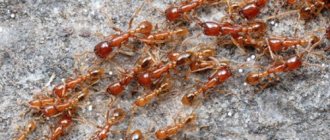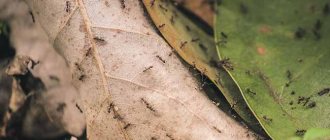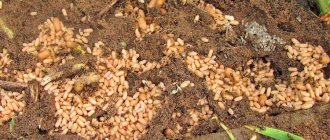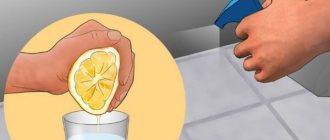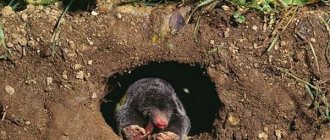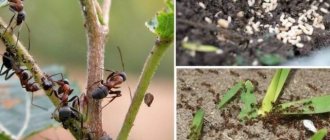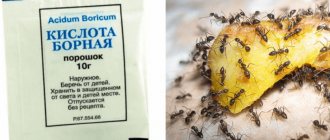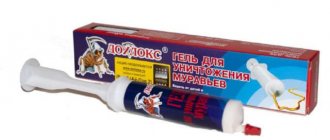Gardeners use greenhouses and greenhouses to grow “capricious” crops. The microclimate created under the shelter affects the formation of a friendly and rich harvest. However, heat and humidity also have a beneficial effect on the life activity of many pests. An ant colony can colonize a greenhouse with already growing plants. An anthill that forms among the seedlings of cucumbers and rooted tomatoes threatens not only the harvest, but also the life of the plants. What control measures to take in such a situation are discussed in this article.
Where did they even come from?
If ants appear in a greenhouse, there may be three reasons:
- The insects went their own way and turned into the greenhouse to investigate. The important thing here is to simply kick them out in time.
- A new nest has appeared on your site, and pests go to the greenhouse to grow aphids there - it’s more convenient. Just get rid of the aphids and scatter the cut garlic cloves over the beds.
- The nest appeared right inside the greenhouse, by digging from outside. It’s not so easy to find - you won’t see any anthill, it’s just a small hole, under which, however, a whole kingdom is already being built. Search and destroy.
First of all, figure out what kind of enemy wandered into your greenhouse. So, in Russia the following types of ants are most often found:
- Black garden ones.
- Red forest ones.
- Brown meadows.
If your site is located near a forest, expect red insects to visit you, but they usually avoid the greenhouse. But closed, warm soil is more attractive to black garden ants, which brazenly build their nests right in the beds. And with our multiple passages underground, we disrupt the root system of everything that grows in the greenhouse, which is why we may not get a harvest. At the same time, black ants feed on plant seeds and seedlings.
But if you meet one of these comrades, proceed very carefully:
Prevention measures
First of all, it doesn’t matter whether it’s chemicals or a folk remedy, you need to choose a gentle method so as not to ruin the young greenhouse. For example, “Mashenka” or “Clean House” will be an excellent means of prevention if ants are frequent guests in your plantings. As for folk remedies, the most appropriate preventive treatment would be the use of garlic.
If you decide to use chemicals to control pests, then carefully read the instructions and follow all the steps prescribed therein. At the same time, be sure to remember the safety rules. Use protective equipment (gloves, mask) to prevent chemicals from coming into contact with your skin and respiratory tract.
"Old-fashioned" methods, time-tested
You can also work with ants using the “wedge by wedge” method. If you cannot drive out black ants, you can scare them away with large red ones. Red forest ants love to destroy the nests of black ones and steal eggs from there. If it so happens that your area with a greenhouse is located right next to a forest belt, then just find forest orderlies there, take some earth from the anthill and make a path like this all the way to the greenhouse. Soon you will see how a whole river runs, takes white eggs from your hearth of black ants, and back. Quite an effective solution. True, this method does not always help, and sometimes both red and black people peacefully coexist with each other.
There are also less risky “old-fashioned” methods of dealing with ants. The most effective is boric acid:
And these methods:
- We take 10 liters of water into a container, pour in two glasses of vegetable oil and the cheapest shampoo, add a bottle of vinegar and mix well. In the place of the largest concentration of insects, we pierce a hole with a peg and pour this mixture into it with a spray bottle. Immediately cover with film for three days.
- If you have enough patience, you can lure ants into a jar with leftover jam. In one visit, many comrades will gather there, although not the entire colony, naturally. But it’s worth it a couple of times – the number of pests will decrease while you look for the main effective method of control.
- Another old-fashioned method is a mixture of brewer’s yeast and honey. Little sweet tooths will eat up, and the remnants of the survivors will go home.
- Here's how to prepare meat bait for ants: mix 2 tablespoons of minced meat with 0.5 tsp. boric acid. Divide this mixture into many small balls and spread along visible ant paths. It is only important that this poison is not accidentally eaten by one of your pets, and therefore during these days always close the door to the greenhouse.
- Ants also don’t like certain smells. Therefore, spread out the remains of coffee grounds, cinnamon, mint, elderberry and tansy leaves, and cut garlic arrows for them in the greenhouse beds.
- Mechanical methods are also important in the fight against ants. Try to constantly loosen the soil in which there are insects.
Ready-made gels, traps and sprays
So, if traditional methods do not help, try modern means. There are special insecticides on sale that are available in the form of gels, pastes and powders. But use them with caution in greenhouses; after all, this is closed soil.
- Dry ant bait is prepared as follows: mix equal amounts of sugar and boric acid, and sprinkle in places where ants accumulate. Just not on the beds themselves!
- The most popular product is Absolut-gel. It is a box containing a syringe with the product drawn into it. Place a few drops on the anthill so that the ants, having tasted it, take this delicacy to the female. As soon as she eats the poison, she will die, and with it the anthill.
- Ordinary “Mashenka” chalk, which is designed to fight cockroaches, will also help drive out ants. Simply place wooden planks on the floor of the greenhouse and paint stripes on them. The poison will stick to the paws of the ants, and they will carry it into the anthill.
- You can also use a stronger insect repellent - there are a lot of these on sale now. Open the ampoule, mix the contents with water, and pour the solution little by little into all the entrance holes of the ants, and then cover it all with film.
- One of the best industrial products is “Grom-2”. Place the granules where the insects live, and they will soon leave.
- If you use the “Great Warrior” gel, you will see how ants will start running in flocks to eat it - like at a buffet table. But literally in a week the pests will disappear completely.
- Interestingly, many special anti-ant products that work well at home are completely useless when fighting in the ground. And some of them are also toxic to plants if they get into the soil.
- There is also a method - spraying the place where these insects gather most with Anteater. But this only affects the place itself, and on a global scale you cannot deal with uninvited guests this way.
- An ultrasonic insect repeller is also effective for greenhouses. Impulses invisible to humans have a depressing effect on ants, which is why they are forced to leave such an area.
But remember that none of the methods can give a 100% guarantee - this issue can only be approached comprehensively.
Ants in a greenhouse
Favorable conditions of closed ground attract insects. They quickly colonize warm, dug-up beds, destroying anthills in them. An irreplaceable orderly in nature becomes dangerous for cultivated plants. The harm of an ant in a garden plot is obvious:
- Colonization of aphids, which are a direct parasite of green plants.
- Destruction of young shoots. Ants chew through seedlings and roots that interfere with the construction of an anthill.
- Aggression against people. Ant bites can cause an allergic reaction in humans.
- Eating seeds and sprouts.
Ants cannot be considered only pests. In addition to harm, they also bring benefits: they loosen the soil, destroy pests and their larvae, and enrich the soil with useful substances.
Depriving ants of their “farm”
Ants build entire colonies of aphids and protect them, which is their greatest harm. Yes, aphids by themselves can appear in a greenhouse - even without ants. But, if they were the first guests, then soon you will see how these small workers themselves drag aphids onto your plants, plant them there, and then visit periodically. For ants, aphids are “cash cows” of their kind. The thing is that they need sugar to survive, and therefore hardworking ants create entire “farms” of aphids on your plants, and then go milk them.
By the way, you can get rid of aphids quite quickly by simply spraying them with the popular drinks Pepsi or Cola. There is no need to dilute anything, just put it in a spray bottle. With subsequent watering, the aphids will easily be washed off the leaves, and the ants will leave offended after them.
Get rid of aphids immediately - at least mechanically remove the infected leaves and treat the plants with this solution: 2 tsp. liquid soap to 2 cups of water. An infusion of garlic and tobacco will also help you get rid of aphids.
Hunting the Queen Ant
But why does it often happen that after serious chemical treatment, ants disappear for a while and then appear again? The fact is that any pesticides kill only adult insects, while the female continues to actively produce offspring.
The Queen always hides in the depths of the galleries; she cannot be found manually. Therefore, scientists today have developed a more cunning and sophisticated method: to make the ants themselves take the poison to their queen. If she dies, the anthill will also spread.
With fire, boiling water and poisons, we mainly destroy working ants, but they are replaced by new ones. You can only catch a queen and drones by surprise by accident, on a warm sunny day after a cool night, when this retinue comes out to warm up. Then you can pour boiling water over it.
If the poison that you left for the ants acts quickly, they will never carry it to their queen. But if the effect is weak, unnoticeable, the queen will be given such a delicacy, and over time it will kill her. To prepare such bait, make a regular sweet 1% boric acid solution, soak cotton wool in it and throw it into a jar. Cover it so that ants can get in. They will bite off pieces of cotton wool and bring it to the queen with the drones. Every two weeks, update the contents of the jar, gradually reducing the concentration of the solution to 0.5%. In just a month and a half, the anthill will be completely destroyed.
Here is one such method: mix honey with dry boric acid in a 2:1 ratio, add a couple of drops of water and bring the mixture to the consistency of sour cream. We place bait on the ant paths and wait for someone to deliver this “treat” to their queen. When boric acid gets inside an insect, it first causes severe itching and then kills it.
On such paths, you can additionally sprinkle the poison “Bazudina”, which comes in granules that look like pupae. The ants themselves bring it into their home.
Getting rid of the anthill
If the anthill is located directly in the greenhouse, remove it immediately. There are many methods.
Fill with homemade compositions
There are two ways to fill an anthill:
- With the first frost, remove the top layer of the anthill with a shovel and apply water under pressure to it.
- In summer, fill the anthill with molasses and water with jam. This will immediately provoke the growth of soil yeast, which in turn will destroy the ants’ reserves for the winter. These smart insects usually retreat from such places.
If ants have settled in the beds in the greenhouse before planting the seedlings, do this:
- Step 1. Prepare two buckets of boiling water.
- Step 2. Using one spade bayonet, dig out the anthill.
- Step 3. Pour boiling water and leave the greenhouse, leaving the door open.
It’s not the ants that die from boiling water, it’s their laid eggs. In this case, the insects grab what is still left and leave.
You can also water ant nests with sunflower oil, if you don’t mind it. Using vegetable oil is even easier: fry the pies, and pour the darkened hot remaining oil into the holes.
Fill with dry material
But the anthills are not only filled, but also dusted with: wood ash, slaked lime, ground pepper, ammonium nitrate and dry mustard.
You can also get rid of an anthill in this way: sprinkle millet directly on it. The ants mistake it for eggs and actively drag it into their house. Next, simply pour water over this “house”, the millet will quickly swell and block all entrances and exits. It will also smell unpleasant to the ants. And dissatisfied insects will soon move from such beds to another place.
Another simple method: loosen the nest you find and sprinkle it with tobacco dust or fluff lime.
We repel with a strong smell
You can drive away ants with scent this way: just place a piece of herring next to the anthill.
Weeds will also help in this matter. You can use wormwood like this: take 400 g of fresh wormwood or 40 g of dry wormwood, pour boiling water over it. Let the grass steep for a day in 10 liters of cold water, strain, and then spray the anthill and the entire surrounding area with a spray bottle.
Tell me how to remove ants from a greenhouse where cucumbers are already planted?
Alexander Kabeshov
I covered the ground with ground black pepper in the tomato greenhouse while we were leaving. But there is no constant rain there. I have tried all the ant preparations and they come back after some time. Now 3 weeks have passed since the pepper - not yet.
Irirna
I have cucumbers planted in a barrel. There are a lot of ants there. Last year I fought with them, and they ruined all my cucumbers. I don’t touch them in this, and they are cucumbers too. When we had a wooden frame for the greenhouse, the ants undermined it all and it collapsed. The struggle was also unsuccessful.
Ekaterina Akhmadeeva
"Thunder-2" and "Muracid". Microgranules "Groma-2" are able to penetrate into the most "ant-infested places": passages, crevices of paths and foundations... Muratsid liquid is used to water anthills in flower beds, lawns, beds, and greenhouses. The effect lasts for a whole month. Or you can prepare an “explosive” mixture yourself: mix boric acid with sugar or sunflower oil with vinegar. At least some will die, and the remainder will move to another place.
In especially severe cases, you can sprinkle anthills with washing powder. They'll probably go, but where?
It is very difficult to get rid of ants using poisons - some will die, the rest will quickly recover. It is better to limit their freedom by placing adhesive belts on the trees. At least there will be fewer aphids.
Andryukha Andreevich
by special means
Natulik
karbofos
Nadezhda Incognito
salt
Name
The best thing is gel-like food baits. They are applied to the paths by ants, near their homes, the ants drag this bait to themselves, feed it to the queen and the entire colony slowly dies out. but it is useless to poison simply with chemicals and the like - part of the anthill with the queen survives, and the reproduction process does not stop.
Tatiana ***
We sprinkled soda and the ants left.


